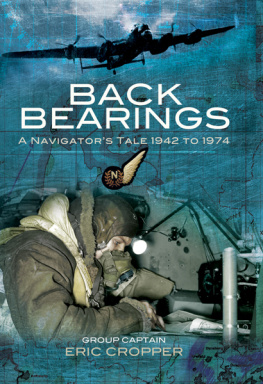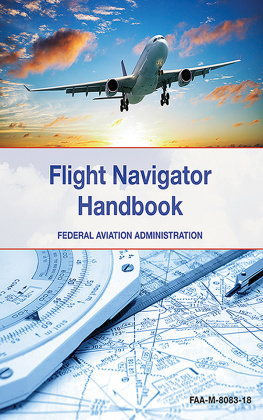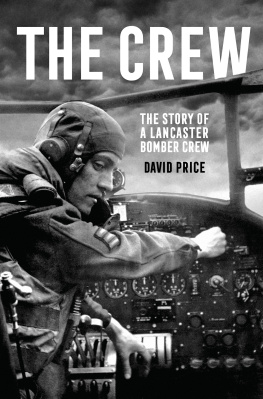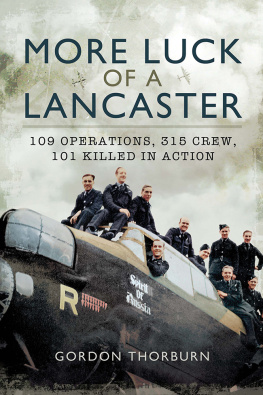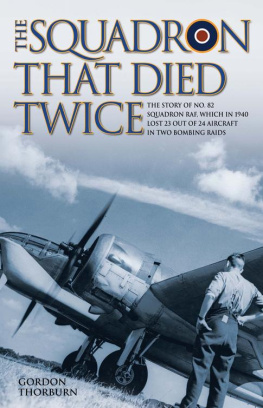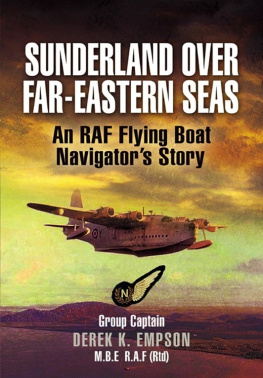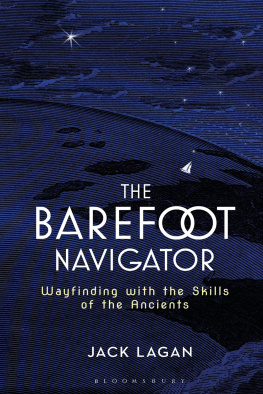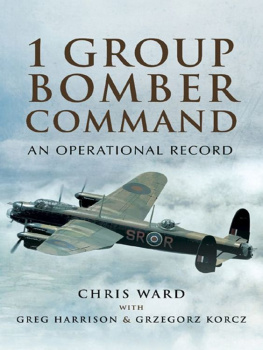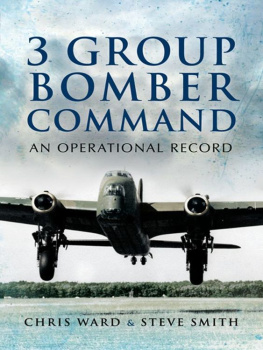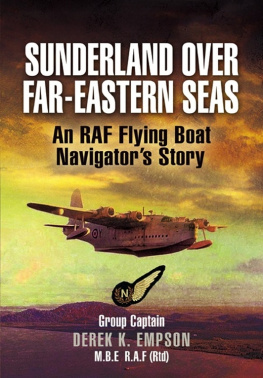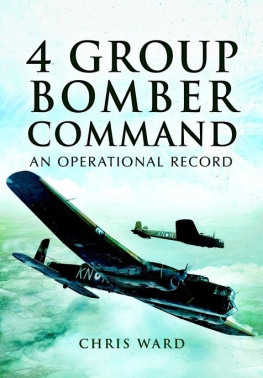Dedication
To Joan
for seventy years
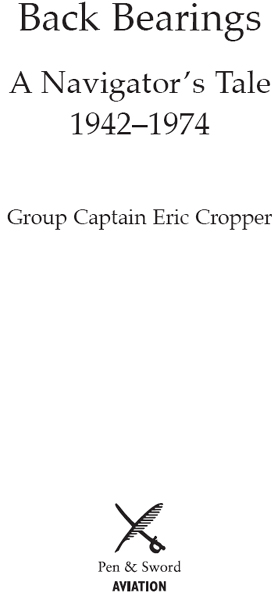
First published in
Great Britain in 2010
By Pen and Sword Aviation
An imprint of
Pen and Sword Books Ltd
47 Church Street
Barnsley
South Yorkshire
S70 2AS
Copyright Eric Cropper 2010
ISBN 978-1-84884-151-2
Print ISBN: 978-1-84884-151-2
ePub ISBN: 9781844688104
The right of Eric Cropper to be identified as the Author of this Work
has been asserted by him in accordance with the Copyright, Designs
and Patents Act 1988.
A CIP record for this book is available from the British Library
All rights reserved. No part of this book may be reproduced or
transmitted in any form or by any means, electronic or mechanical
including photocopying, recording or by any information storage and
retrieval system, without permission from the Publisher in writing.
Typeset in 11/13pt Palatino
by Mac Style, Beverley, E. Yorkshire
Printed and bound in Great Britain
by CPI UK
Pen and Sword Books Ltd incorporates the imprints of Pen and Sword
Aviation, Pen and Sword Maritime, Pen and Sword Military,
Wharncliffe Local History, Pen and Sword Select, Pen and Sword
Military Classics and Leo Cooper.
For a complete list of Pen & Sword titles please contact
PEN & SWORD BOOKS LIMITED
47 Church Street, Barnsley, South Yorkshire, S70 2AS, England
E-mail:
Website: www.pen-and-sword.co.uk
Introduction
When we are travelling through life or across the earth we want to know where we are and how to get to where we want to be. This is the purpose of navigation, which is both a science and an art: very often science alone or art alone will not help us, especially when chance plays its part. This book is the story of one navigator in the days when air navigation was still rudimentary and open to error.
On the cover of the Air Almanac the bible for those who sought to find their position by observing heavenly bodies there used to be a vignette of a doleful medieval individual using a backstaff, a primitive sextant, below which was a scroll bearing the legend Man Is Not Lost. This phrase was adopted as a motto by the air navigation fraternity, usually used ironically. I originally chose it as the title for this book, and wrote six chapters before Group Captain Dickie Richardson (of a slightly earlier era) used it for his memoirs: I suppose I should have expected it. My present title refers to the way in which a navigator can get some idea of his present position by looking backwards, an occupation most of us tend to indulge in as we get older.
My career as a practising navigator covered some twenty-five years, from 1943 to to 1968, when enormous advances were being made in aviation in general and navigation systems in particular. This book lies somewhere between an autobiographical memoir and a not too technical review for the general reader of the development of air navigation as I knew it. I kept no journals, only engagement diaries in some years, and so I have had to rely largely on fickle memory, aided by my flying logbooks and those of my navigation logs and charts which still survive. Any errors of fact are therefore almost sure to be my own, although I have referred to supposedly authoritative sources from time to time.
Inevitably the story includes the strands of family and domestic life inextricably interwoven with the demands of the job in the Royal Air Force, and indeed I have probably not placed sufficient emphasis on the part played by my loyal, long-suffering and enterprising wife in a variety of circumstances and climates. This book is a tribute to her and our marriage of nearly sixty-five years.
The trade of air navigator is a dying one, and in civil aviation it has been dead for some years. Satellite navigation systems can position an aircraft, a ship, a vehicle and even a humble walker anywhere on the earths surface with an accuracy and a reliability undreamed of sixty years ago. Perhaps this book will give some flavour of more primitive days when man in the air was very frequently lost and navigation was often by guess and by God.
CHAPTER ONE
Starting
A file of khaki-clad figures, each man clutching the bayonet scabbard of the man in front, stumbled and cursed their way across rough farmland in pitch darkness. This was a night marching exercise, and as far as I was concerned, my introduction to the practice of navigation. I joined the Home Guard, aged 17, at the end of 1940 when it was still known as the Local Defence Volunteers (or, more colloquially, Look, Duck and Vanish). The members of our section were mostly boys about my age, having left school but not being old enough to join or be conscripted into the Armed Forces. Our NCOs were aged Great War veterans (probably between 40 and 50 years old), and we all took ourselves very seriously. The immediate threat of a German invasion had receded somewhat by this time, and we were adequately uniformed and equipped, armed with Canadian 0.30 rifles (later Sten guns), and well drilled in infantry tactics.
We had had training in map reading, using the incomparable one-inch Ordnance Survey maps, and in using a hand-held marching compass. We were taught to measure on the map the true bearing of the required line of march (that is, its angular relationship with True North) and to follow this line using the same reading on the marching compass. As I was to discover later, navigation is never so simple: no magnetic compass ever points to True North, which is the direction of the Geographic North Pole the one at the top of the terrestrial globe. The earths magnetic field is not only asymmetrical but varies slightly year by year. At that time the magnetic pole was somewhere in Northern Canada, and compasses pointing to it read about 12 west of True North, known as the magnetic variation and shown on maps. We had therefore to make a correction to the true bearing before marching off into the night.
Off we went, in the time-honoured formation probably used before Waterloo, falling into hollows, tripping over bushes, and swearing bitterly. After three-quarters of an hour or so our objective was nowhere in sight; we should have reached it after fifteen minutes. A halt was called and a torchlit conference ensued. Navigation error was to blame: we had applied magnetic variation the wrong way, east instead of west, and were consequently marching 24 (nearly an hour on the clock face) out of the required direction. We then evolved the magic formula Map to compass add. Like most simple solutions, this of course only applied in certain circumstances in that particular place and date in the northern hemisphere but this did not affect the gallant Home Guard.
At the beginning of 1942, when I had just reached the age of 18, I decided to join the Royal Air Force and, naturally, to be a fighter pilot. I had thoroughly enjoyed the Home Guard but I felt that if I was going to fight, I would rather do it sitting down and with some substantial firepower under my control. I reported to the RAF Recruiting Office in the city of Leeds, and was interviewed by an elderly flight lieutenant wearing a pilots wings and Great War medals. He did not seem to be very impressed with my ambition to be a fighter pilot, and after looking at my educational qualifications and giving me some mental arithmetic problems, announced that I was more suited to be an observer. However, he would send all my details to the Aircrew Selection Centre at Cardington and I would be called for more rigorous selection tests in due course. With that I had to be satisfied, though the thought of sitting in the back of an aircraft shuffling maps and making calculations did not seem very attractive.
Next page
